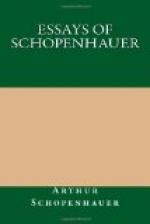however. Moreover, through the comparative shortness
of such periods, the data of remote times are with
difficulty collected; hence the matter can be most
conveniently observed in one’s own age.
An example of this taken from physical science is
found in Werter’s Neptunian geology. But
let me keep to the example already quoted above, for
it is nearest to us. In German philosophy Kant’s
brilliant period was immediately followed by another
period, which aimed at being imposing rather than
convincing. Instead of being solid and clear,
it aimed at being brilliant and hyperbolical, and,
in particular, unintelligible; instead of seeking
truth, it intrigued. Under these circumstances
philosophy could make no progress. Ultimately
the whole school and its method became bankrupt.
For the audacious, sophisticated nonsense on the one
hand, and the unconscionable praise on the other of
Hegel and his fellows, as well as the apparent object
of the whole affair, rose to such a pitch that in
the end the charlatanry of the thing was obvious to
everybody; and when, in consequence of certain revelations,
the protection that had been given it by the upper
classes was withdrawn, it was talked about by everybody.
This most miserable of all the philosophies that have
ever existed dragged down with it into the abyss of
discredit the systems of Fichte and Schelling, which
had preceded it. So that the absolute philosophical
futility of the first half of the century following
upon Kant in Germany is obvious; and yet the Germans
boast of their gift for philosophy compared with foreigners,
especially since an English writer, with malicious
irony, called them
a nation of thinkers.
Those who want an example of the general scheme of
epicycles taken from the history of art need only
look at the School of Sculpture which flourished in
the last century under Bernini, and especially at its
further cultivation in France. This school represented
commonplace nature instead of antique beauty, and
the manners of a French minuet instead of antique
simplicity and grace. It became bankrupt when,
under Winckelmann’s direction, a return was
made to the antique school. Another example is
supplied in the painting belonging to the first quarter
of this century. Art was regarded merely as a
means and instrument of mediaeval religious feeling,
and consequently ecclesiastical subjects alone were
chosen for its themes. These, however, were treated
by painters who were wanting in earnestness of faith,
and in their delusion they took for examples Francesco
Francia, Pietro Perugino, Angelico da Fiesole, and
others like them, even holding them in greater esteem
than the truly great masters who followed. In
view of this error, and because in poetry an analogous
effort had at the same time met with favour, Goethe
wrote his parable Pfaffenspiel. This school,
reputedly capricious, became bankrupt, and was followed
by a return to nature, which made itself known in
genre pictures and scenes of life of every
description, even though it strayed sometimes into
vulgarity.




